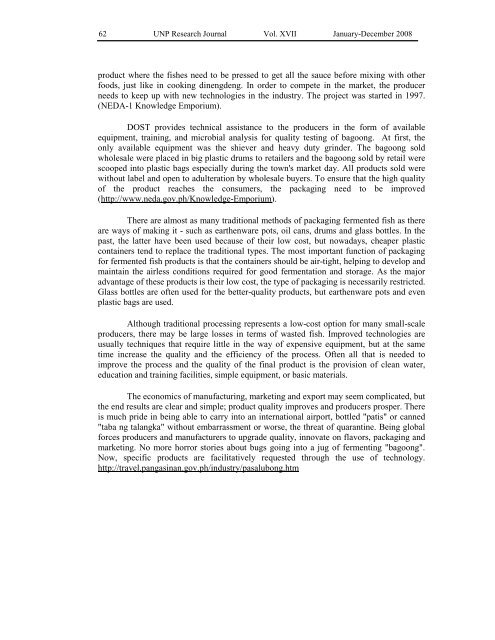Prototyping of a Mechanized Bagoong Squeezer - EISRJC
Prototyping of a Mechanized Bagoong Squeezer - EISRJC
Prototyping of a Mechanized Bagoong Squeezer - EISRJC
Create successful ePaper yourself
Turn your PDF publications into a flip-book with our unique Google optimized e-Paper software.
62 UNP Research Journal Vol. XVII January-December 2008product where the fishes need to be pressed to get all the sauce before mixing with otherfoods, just like in cooking dinengdeng. In order to compete in the market, the producerneeds to keep up with new technologies in the industry. The project was started in 1997.(NEDA-1 Knowledge Emporium).DOST provides technical assistance to the producers in the form <strong>of</strong> availableequipment, training, and microbial analysis for quality testing <strong>of</strong> bagoong. At first, theonly available equipment was the shiever and heavy duty grinder. The bagoong soldwholesale were placed in big plastic drums to retailers and the bagoong sold by retail werescooped into plastic bags especially during the town's market day. All products sold werewithout label and open to adulteration by wholesale buyers. To ensure that the high quality<strong>of</strong> the product reaches the consumers, the packaging need to be improved(http://www.neda.gov.ph/Knowledge-Emporium).There are almost as many traditional methods <strong>of</strong> packaging fermented fish as thereare ways <strong>of</strong> making it - such as earthenware pots, oil cans, drums and glass bottles. In thepast, the latter have been used because <strong>of</strong> their low cost, but nowadays, cheaper plasticcontainers tend to replace the traditional types. The most important function <strong>of</strong> packagingfor fermented fish products is that the containers should be air-tight, helping to develop andmaintain the airless conditions required for good fermentation and storage. As the majoradvantage <strong>of</strong> these products is their low cost, the type <strong>of</strong> packaging is necessarily restricted.Glass bottles are <strong>of</strong>ten used for the better-quality products, but earthenware pots and evenplastic bags are used.Although traditional processing represents a low-cost option for many small-scaleproducers, there may be large losses in terms <strong>of</strong> wasted fish. Improved technologies areusually techniques that require little in the way <strong>of</strong> expensive equipment, but at the sametime increase the quality and the efficiency <strong>of</strong> the process. Often all that is needed toimprove the process and the quality <strong>of</strong> the final product is the provision <strong>of</strong> clean water,education and training facilities, simple equipment, or basic materials.The economics <strong>of</strong> manufacturing, marketing and export may seem complicated, butthe end results are clear and simple; product quality improves and producers prosper. Thereis much pride in being able to carry into an international airport, bottled "patis" or canned"taba ng talangka" without embarrassment or worse, the threat <strong>of</strong> quarantine. Being globalforces producers and manufacturers to upgrade quality, innovate on flavors, packaging andmarketing. No more horror stories about bugs going into a jug <strong>of</strong> fermenting "bagoong".Now, specific products are facilitatively requested through the use <strong>of</strong> technology.http://travel.pangasinan.gov.ph/industry/pasalubong.htm
















